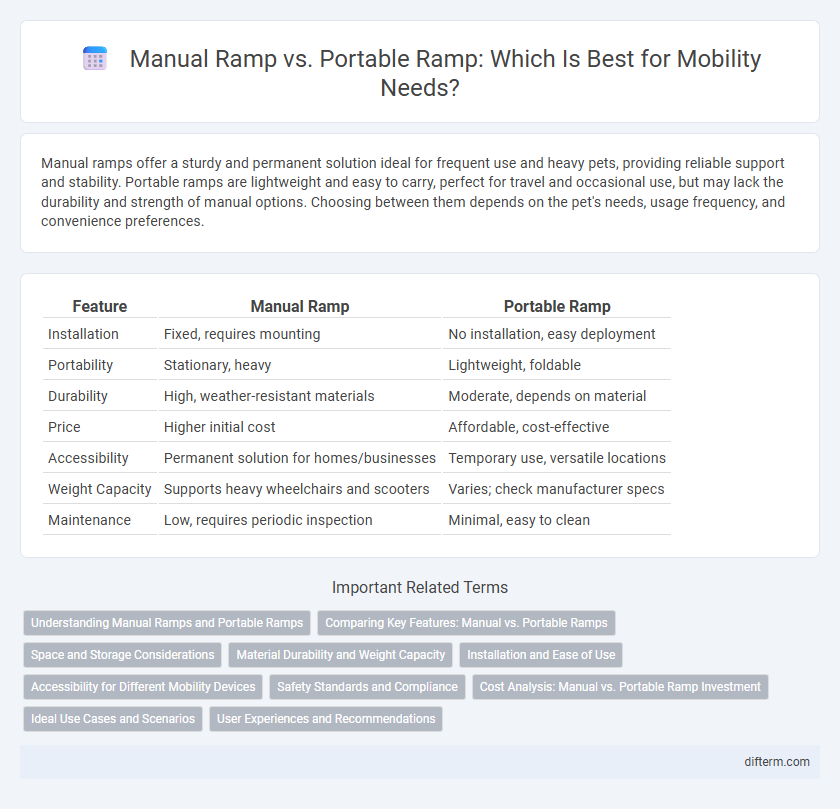Manual ramps offer a sturdy and permanent solution ideal for frequent use and heavy pets, providing reliable support and stability. Portable ramps are lightweight and easy to carry, perfect for travel and occasional use, but may lack the durability and strength of manual options. Choosing between them depends on the pet's needs, usage frequency, and convenience preferences.
Table of Comparison
| Feature | Manual Ramp | Portable Ramp |
|---|---|---|
| Installation | Fixed, requires mounting | No installation, easy deployment |
| Portability | Stationary, heavy | Lightweight, foldable |
| Durability | High, weather-resistant materials | Moderate, depends on material |
| Price | Higher initial cost | Affordable, cost-effective |
| Accessibility | Permanent solution for homes/businesses | Temporary use, versatile locations |
| Weight Capacity | Supports heavy wheelchairs and scooters | Varies; check manufacturer specs |
| Maintenance | Low, requires periodic inspection | Minimal, easy to clean |
Understanding Manual Ramps and Portable Ramps
Manual ramps are fixed structures that provide stable access for wheelchairs and mobility devices, typically installed at homes or buildings for consistent use. Portable ramps offer flexibility and convenience, allowing users to transport and set them up quickly for temporary access in various locations. Both types enhance mobility independence but differ in installation, weight, and ease of transport, making the choice dependent on user needs and usage frequency.
Comparing Key Features: Manual vs. Portable Ramps
Manual ramps are typically fixed structures designed for permanent installation, offering high stability and durability for frequent wheelchair access. Portable ramps prioritize lightweight materials such as aluminum, enabling easy transport and setup for temporary or occasional use in diverse locations. Key differences in weight capacity, length, and surface texture impact suitability, with manual ramps often supporting heavier loads and portable ramps providing versatility and convenience.
Space and Storage Considerations
Manual ramps typically require fixed installation and permanent space allocation, limiting flexibility in compact areas. Portable ramps offer superior storage convenience by folding or disassembling, ideal for users with limited storage or variable access needs. Space-efficient design in portable ramps enhances mobility solutions by combining accessibility with ease of storage.
Material Durability and Weight Capacity
Manual ramps are typically constructed from heavy-duty aluminum or steel, offering superior material durability and a higher weight capacity, often supporting up to 1,000 pounds or more. Portable ramps, made from lightweight aluminum or composite materials, prioritize ease of transport and quick deployment but usually have a lower weight capacity, generally ranging between 600 and 800 pounds. Both types ensure safety and accessibility but differ significantly in their balance between durability and portability.
Installation and Ease of Use
Manual ramps require a fixed installation, often involving tools and professional assistance, making them less flexible for changing locations. Portable ramps offer simple, tool-free setup with lightweight materials designed for quick deployment and easy transport. Their ease of use makes portable ramps ideal for varied environments and immediate accessibility needs.
Accessibility for Different Mobility Devices
Manual ramps provide fixed accessibility solutions primarily for wheelchair users but may be limited in accommodating scooters or walkers due to their stationary design. Portable ramps offer versatile accessibility for a wider range of mobility devices, including wheelchairs, scooters, and walkers, thanks to their adjustable and easy-to-move structure. The flexibility of portable ramps enhances usability in multiple environments, improving access for various mobility needs.
Safety Standards and Compliance
Manual ramps typically comply with ADA (Americans with Disabilities Act) safety standards, featuring sturdy non-slip surfaces and secure handrails to ensure stability during use. Portable ramps are designed to meet OSHA regulations, emphasizing lightweight materials for easy transport while maintaining structural integrity and slip resistance. Both ramp types must undergo rigorous testing and certification to guarantee compliance with local accessibility codes and safety requirements.
Cost Analysis: Manual vs. Portable Ramp Investment
Manual ramps typically require lower initial investment but may incur higher long-term maintenance costs due to wear and tear, while portable ramps involve a higher upfront purchase price with minimal upkeep expenses. Portable ramps offer flexibility and ease of transport, which can reduce labor costs and improve efficiency in various mobility scenarios. Evaluating total cost of ownership, including durability, installation time, and mobility requirements, is essential to determine the most cost-effective ramp solution.
Ideal Use Cases and Scenarios
Manual ramps offer a sturdy solution ideal for permanent or semi-permanent installations, such as home entrances or building thresholds where consistent accessibility is required. Portable ramps excel in scenarios demanding flexibility, like travel, temporary events, or vehicle loading, due to their lightweight design and ease of transport. Choosing between manual and portable ramps depends on frequency of use, mobility needs, and the environment where access solutions are applied.
User Experiences and Recommendations
Manual ramps offer sturdy, permanent solutions that provide consistent reliability for users needing daily accessibility, especially benefiting wheelchair users in high-traffic areas. Portable ramps excel in convenience and versatility, ideal for individuals requiring temporary access or frequent relocation, with lightweight models enhancing ease of transport and setup. User feedback emphasizes prioritizing ramp weight, length, and surface grip to ensure safety and comfort, recommending manual ramps for long-term installations and portable ramps for dynamic environments.
manual ramp vs portable ramp Infographic

 difterm.com
difterm.com